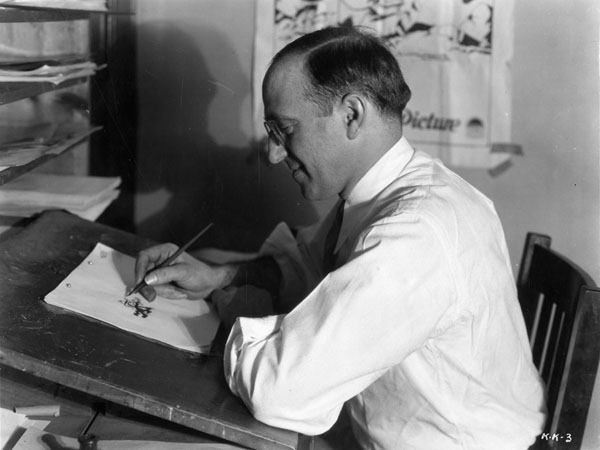
Ben Harrison is best known in classic American animation history as the co-producer/director of Mintz Studio Krazy Kat cartoons released from 1927 to 1940. Harrison’s partner Manny Gould has become more renowned for work done after his association with Krazy Kat—specifically, his exuberant animation for Warner Bros., Jerry Fairbanks Productions, and De-Patie/Freleng. As for Harrison, not much has been known about his career, aside from anecdotal evidence—until recently.
A few months ago, Jerry Beck alerted me to a series of Harrison’s handwritten biographical notes, located at the Billy Ireland Cartoon Library & Museum in Columbus, Ohio. These notes, a written overview of Harrison’s career, provide a vast insight into an important but unsung figure who appears never to have been formally interviewed otherwise. Much of Harrison’s silent filmography—the silent Krazy Kat cartoons, along with the Mutt and Jeff cartoons released pre-1925—have a regrettable survival rate, with very few titles extant. Harrison’s cartoons for Columbia made during the 1930s and 1940s have received only a moderate assessment, at best, from animation historians—though the “Complimentary Mintz” article (co-written by Charlie Judkins) made an attempt to rectify this. Identifying Harrison’s later work in television commercials is difficult, since much of early television broadcasting has not been saved for posterity.
Presented here are Ben Harrison’s notes, transcribed verbatim, with annotations in bold for further clarification, and further details provided by his daughter Myrna Harrison in a recent phone conversation. (The Harrisons’ familial interest in the arts has extended to Myrna, as you will see in a detailed rundown of her career.)
Significantly, Harrison’s notes mention a “last meeting,” indicating a previous conversation with an unknown party about his animation career. This vague mention is perplexing, since no interviewer names are written in the notes.
As expected, the ongoing closures of research libraries and museums due to COVID-19 have obstructed further investigation that would support a few claims in the text. However, there is a good chance there will be an addendum to this post in a later date, with more photographs and possible clarifications.
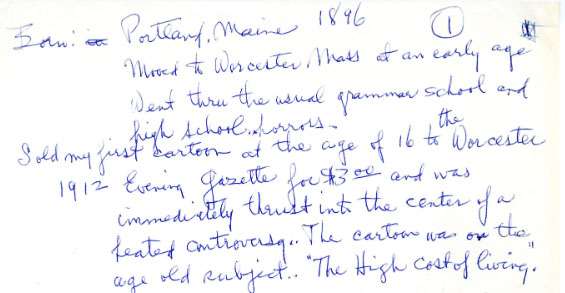
1896—Born in Portland, Maine [on November 30]…moved to Worcester, Massachusetts at an early age…went thru the usual grammar school and high school horrors…
Raised in a Jewish family, Ben had moved to Worcester by 1900, where his father Louis was listed in the census as a “teacher of languages.” Myrna said Louis was “a Talmudic scholar who translated Ecclesiastes into Yiddish” and had translated much of the Old Testament.
The “horrors” Harrison mentions might allude to a stammering problem, which affected him in his young life; evidently, this continued up to the early 1950s, but to a lesser extent. As Myrna explains, “The teachers would make him get up in front of the class and say, ‘Ben, if you just pay attention now, you won’t stutter.’”
1912—Sold my first cartoon at the age of 16 to the Worcester Evening Gazette for $3.00 and was immediately thrust into the center of a heated controversy…The cartoon was on the age old subject, “The High Cost of Living.” Mr. John Q. Public was in a butcher shop getting a bid on a steak…The butcher had his hand on the scale and to make it funnier, I attached a brick hanging from the scale…That did it…The New England Grocers and Provision Dealers Association resented such cheap attempts at scurrilous caricature and insisted on an apology…Immediately, people began taking sides. The pros said, “If the shoe fits, wear it”…and the cons said ”We ought to teach him a lesson…” I was the newsboy that was selling the butcher his newspaper. The editors thought it was terrific…It was the first time they received “Letters to the Editor”…Went to an art school in Boston…The Fenway School of Illustration and finally…
Volumes of The Worcester Evening Gazette, dating from 1907 to 1938, are available on microfilm at both the Boston and Worcester public libraries. However, they have not been digitized online as of this writing, nor are the hard copies accessible at present, so Harrison’s early publishing work cannot be reproduced here. His WWI draft registration card, dated June 5th, 1918, describes him as being self-employed as a news dealer, still residing in Worcester, Massachusetts. The 1920 Worcester census, dated January 5th, lists his occupation as a street newsboy, still living with his mother Minnie and his siblings.
1920—Landed in New York with several comic strips. Saw a lot of art editors. Got a lot of good wishes but no jobs and finally got into an animation studio… Jefferson Film Corp… where they were doing Mutt and Jeff animated cartoons. Started cleaning drawings and after wearing my fingers down to the knuckles, they made me an assistant animator and finally a full animator, and then figuring they could make more money with the studio closed, they folded and closed the studio…Having developed a sharp appetite, it was back to Worcester again, and mother’s home cooking.
The last known Mutt and Jeff cartoon under the Jefferson Film Corporation, Down in Dixie, was released January 23, 1923. No exact date on the studio’s closure is known, but it would have ceased its operations sometime around late 1922.
1922—So, back to New York again and started with Out of the Inkwell and Max Fleischer, where I also worked on the first Song Cartoons…This was before the bouncing ball…and the characters danced on a pan shot of the words… “Mother, mother, mother, pin a rose on me…” an old time popular song.
Harrison’s stint at the Fleischer studio is supported by labeled caricatures of the staff, which includes Harrison (listed as “Ben”), drawn by the studio’s top animator Dick Huemer on November 23, 1923, marking the date of their relocation from 129 East 45th St. to 1600 Broadway. The first Song Car-Tunes were released in early 1924; Mother Pin a Rose on Me was released in June.
Fleischer caricatures, 1923 relocation (click to enlarge)
1924—A new studio opened and I switched to the Earl Hurd studio where the drawings were all on paper, and the drawings were cut out and pasted on black paper…Why?? I never learned…
Here is the answer: Earl Hurd had started a new series of “Cartoon Comedies” for Educational Pictures known as Pen and Ink Vaudeville, animated in the fashion Harrison describes. The series was short-lived, with only 13 cartoons released from 1924 to 1925. Here is an example, via Mark Kausler.
1925—Mutt and Jeff Studios reopened but this time, they were being sold on a state-rights basis, by a company known as Short Films Syndicate, consisting of Hal Hodes and Joe Pincus…the New York rights were sold to Nat Cohn and Irving Wormser who later joined in with Joe Brandt, Harry and Jack Cohn and became the sales department of Columbia Pictures… Charlie Bowers wrote the stories on the first Mutt and Jeff cartoons, but later got involved in the Gus Gimlet cartoons, which I worked on and told you about on our last meeting, and that was the beginning of Associated Animators, an ill-fated debut.
Burt Gillett was the president and the rest of the officers were Manny Gould, Dick Huemor [sic] and myself. I think I was the treasurer, with nothing to treasure. Then our first disaster hit us…We started to do a documentary of a dirigible that blew up in a storm…while over in Pennsylvania…the last words of one of the officers were (in a title…it was silent) “I am losing my seat.” That wasn’t all we lost… I remember that beautiful gilt-edge stock that was issued. I used it to plug up a hole in my shoes… That was the beginning of Harrison-Gould Studios.
According to Myron Waldman, who as a teenager, worked briefly at the studio in its first year, Associated Animators operated their business at the Candler Building, on 220 West 42nd St.
Harrison’s mention of Charlie Bowers starting a new series of cartoons is intriguing. However, no evidence of his plans or the Gus Gimlet character could be found as of this writing. Motion Picture News announced that Associated Animators had been granted a charter from New York State, thus becoming incorporated by July 25th, 1925. The following month on August 31st, as reported by The Film Daily, Max Fleischer filed an injunction against Associated Animators, which included Harrison. Fleischer brought them to court, accusing them of infringement using “secret processes” which they had learned during their employment on the Out of the Inkwell cartoons.
1926—Then we started doing the animated jokes for Literary Digest…that was a Godsend…When the Mutt and Jeff people would go away on a weekend and leave us to dig up the payroll, we could always pick up a check on the animated jokes…They [Mutt and Jeff] were doing very good in New York…running up and down Broadway, but no so good in the rest of the country…So once more they folded…
The “animated jokes” cited as having been made for Literary Digest were intended for Fun From the Press, an established series of novelty shorts from the early 1920s. As for the Mutt and Jeff cartoons, Dick Huemer recollected to Joe Adamson that production ceased when strip creator Bud Fisher withdrew his financial support. The October 6th, 1926 issue of Exhibitor’s Herald mentions Huemer returning to Fleischer’s studio after having served as vice-president of Associated Animators.
Late 1926—Since Charlie Mintz was in the same building with us, on 42nd St., and he needed Krazy Kat cartoons, he came in and ordered 6 Krazy Kat cartoons…and they started running in all the Broadway theaters.
In the 1925-26 fiscal year, animator Bill Nolan had operated a studio in Long Branch, New Jersey to make a series of cartoons featuring Krazy Kat, which were both produced and distributed by Margaret Winkler. When Winkler renewed the series for a second season, now under the distribution of Film Booking Offices (FBO), Nolan at first immersed himself in production as before. Stomach Trouble, released as late as March 1927, is one of the rare surviving examples of that second season credited to Nolan.

Ben Harrison walk cycle (courtesy of Mark Newgarden)
The earliest mention of Ben Harrison and Manny Gould establishing their firm to take charge of the Krazy Kat cartoons is noted in a letter agreement with animator Art Davis dated March 7th, 1927. It seems Mintz began testing Harrison and Gould to replace Nolan midseason, presumably at a cheaper price—a dry run for Mintz’s later dealings with Walt Disney and his series of Oswald the Lucky Rabbit cartoons, produced for Universal the following year.
1927—We signed up with Mintz for Krazy Kat, distributed thru Paramount Pictures…26 pictures a year…Our money problem solved. By a strange coincidence, our first pictures played the Paramount theatre during the weekend that Lindberg [sic] crossed the Atlantic and landed in Paris… Of 26 pictures made, 19 played on Broadway. That meant that they also picked up the chain theaters, which built the grosses to respectable profits.
The same 1927 letter agreement mentions that Harrison and Gould two operated their studio at 200 West 42nd Street, adjacent to the Candler Building where Charles Mintz and Margaret Winkler occupied their office spaces. Harrison mentions aviator Charles Lindbergh’s famous non-stop transatlantic flight between New York and Paris, where he landed on May 21th, 1927. The Krazy Kat cartoon Burnt Up was released May 9th, and The Night Owl was released May 23, two days after Lindbergh had landed in Paris, likely making those two films the titles Harrison recalls. Both films were distributed through FBO.
With the third season of Charles Mintz-produced Krazy Kat shorts, Paramount took over for FBO as distributor. The first title distributed by Paramount was Sealing Whacks, released August 1, 1927. By February 1928, Harrison and Gould moved to another location at 71 West 45th Street, as noted in another letter agreement addressed to Art Davis. The staff photograph seen below was published as part of a special piece on Harrison and Gould’s Krazy Kat studio in the May 1, 1928 issue of Paramount Around the World magazine.
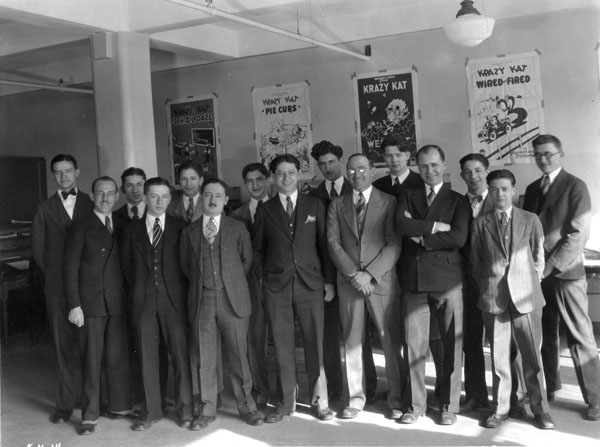
Krazy Kat staff in 1928
1928—Sound…That was a new bugaboo…The prophets of Paramount said…”It was just a ‘passing fancy’ and would go away if you didn’t any attention to it”…Well, it didn’t! We had already figured out the meaning of the markings on the metronome…The numbers indicated the beats to the minute…Since these were 1440 frames, or 90 ft. to the minute, the number 120 meant 12 frames to the beat – 144 meant 10 frs. to the beat and so on…Now, we had to prove it…So I wrote a Hawaiian story…and it was booked into the Rivoli Theatre on Broadway…Mintz knew nothing about it…The musical director of the Rivoli immediately saw the possibilities and he scored the cartoon accordingly. Soon reports started to filter in to Mintz’s office that we were already into sound…He kept insisting that “it was only a passing fancy”…He finally took us to the theatre. There it was as big as life. It was beautifully scored…They had a blue light turned on the screen…Mintz turned to me and said, “O.K., you win,” and that was our beginning in sound…
 The “Hawaiian story” Harrison mentions is possibly The Lone Shark, released April 12, 1929; some Tennessee newspapers in May touted it as a “synchronized cartoon.” No other Krazy Kat cartoon before the series’ later distribution by Columbia holds such a claim, in either internal documentation or news stories intended for the public.
The “Hawaiian story” Harrison mentions is possibly The Lone Shark, released April 12, 1929; some Tennessee newspapers in May touted it as a “synchronized cartoon.” No other Krazy Kat cartoon before the series’ later distribution by Columbia holds such a claim, in either internal documentation or news stories intended for the public.
Later 1929—We shifted over to Columbia Pictures [by June 25] and we started recording at the Victor recording plant in Camden, N.J. At first, we recorded in actual wax records… That was another new problem…Sometimes, the projectionist wouldn’t synchronize them properly, and what a headache that was. There was a man there from Columbia who kept insisting he want to hear the footbeats… That’s why you’ll hear the heavy thuds on some of the early sound cartoons. But then, later that year, they learned how to put the soundtracks on film and everything, including the sound effects, was done at the same time…If a mistake was made, they would have to start all over again…Then they discovered how to do the music in sequences…sound effects in sequence…voices in sequences…and those put them all together in the dubbing…
Ratskin, released a few weeks later on August 15, was the studio’s first official sound release, as well as the first distributed by Columbia. The sound-on-disc methods account for why many of the first season entries were not included in television distribution packages in the 1950s.
1930—Moved to Hollywood [on February 12]…and continued with the Krazy Kats…Recorded at Columbia Studios…But instead of saving money, costs kept rising… Studios were miles apart… where in New York, everything was clustered together in a few blocks… We missed the New York atmosphere.
After moving to California, Harrison shared a room with Gould and Jimmy Bronis, Mintz’s studio manager (and lyricist of Krazy Kat’s theme song “The Kat’s Meow”), according to the 1930 Los Angeles Census.
In approximately 1931, Harrison married a hat designer named Ruth Hildebrand. The two had previously met on the Upper West Side in New York sometime in the late 1920s, finding a common ground in the conservative religious upbringings of their families. Their marriage license cannot be found in public online records, possibly because the two eloped to Tijuana, Mexico. The couple’s only child, Myrna, was born January 31, 1932.
While Harrison and Gould shared joint credit on the Krazy Kat cartoons, Al Eugster recalled the division of their labor in an interview with Mike Barrier: Harrison wrote the stories and handed out scenes to the animators, while Gould mostly animated.
One detail Harrison overlooked in his notes took place in early 1933. Columbia cut Harrison and Gould’s salaries—along with those of Dick Huemer and Sid Marcus—on the claim that their cartoons for Mintz were unprofitable. The four walked out of the studio to settle this dispute, but eventually, all but Huemer returned to Mintz. This would have transpired before March 16, 1933, the day when Huemer was hired at Walt Disney’s studio.
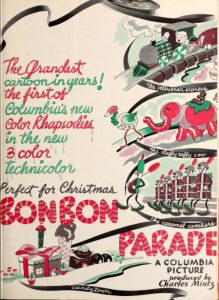
1936—Color came in…Everything was a production. The backgrounds overshadowed the animation… We rediscovered the idea pictures… Ideas and gags were the only important feature of cartoons. I took over the Color Rhapsodies… Pictures like The Stork Takes a Holiday [released June 11, 1937]…storks go on strike…
The Bon Bon Parade [released December 5, 1935]…Dusted off every Christmas and sold as a holiday attraction, year after year after year…
Dr. Bluebird [released February 5, 1936]…Bluebirds put on a show on a windowsill for a kid with a broken leg…utilizing caricatures of Laurel + Hardy as bluebirds, Marx Bros…Chaplin and all the comics…The Audubon Society loved it…
And many more including my share of stinkers…
1940 or thereabouts—Charlie Mintz passed away [earlier on December 30, 1939]– and in a few years, I was fired…followed by a succession of managers and the studio folded.
Harrison’s last known credit was on the Color Rhapsody The Timid Pup, released August 1st, 1940. The 1940 Los Angeles census lists Harrison without any occupation; this census is dated April 30th, undoubtedly after Harrison’s termination from Screen Gems. However, by 1942, his draft registration card lists him as a self-employed cartoonist, based at his home on Doheny Drive. Shortly before the family moved to New York, Myrna recalled, her father briefly took a job painting boats. Myrna said, “They made fun of him, probably because he stuttered, he was fairly short, he was Jewish… he worked [at the painting firm] maybe less than a week.”
1942—Back to New York where I tied up with the Office of War Information and worked on a series of propaganda cartoons for the government during World War II… They were translated into many, many languages, and run in caves, barns and anything that could hold people. They were accompanied by actors of various countries who had a ball making fun of Tojo, Mussolini and Hitler and were generally fables…This lasted thruout [sic] to war, and was generally the beginning of the United Nations Film Library.
1948—Television…Sold my first cartoon to N.B.C. It was a sign-off using Brahms’ Lullaby…with a chorus of 8 people from the Metropolitan Opera Chorus as soon as we discovered that Dr. Graf, the choral master of the Metropolitan Opera was going to be there as a representative of N.B.C. He complimented me on the choice of singers…Jack Shaindlin, the musical director of Fox Films East, was my conductor…It ran every night at about eight o’clock which was the sign off hour at that time.
1949—Started my first commercials for T.V. and Benton + Bowles did Diamond Crystal Salt, H.O. Oats and Post Toasties and then the first Tide commercials…Did Dreft, Oxydol and the P + G [Proctor & Gamble]…
Harrison operated his television studio at 245 West 55th St., stationed one floor above Film Graphics (supervised by former Disney artist Lee Blair). Variety reported earlier on July 9, 1947 that Harrison produced an animated jingle for Post cereals, which aired among the opening and closing commercials for the Brooklyn Dodgers broadcasts on WCBS-TV (CBS-NY). The Variety blurb also claimed that the Radio City Music Hall Choir, under the direction of Kay Holley, provided the singing for the jingle.
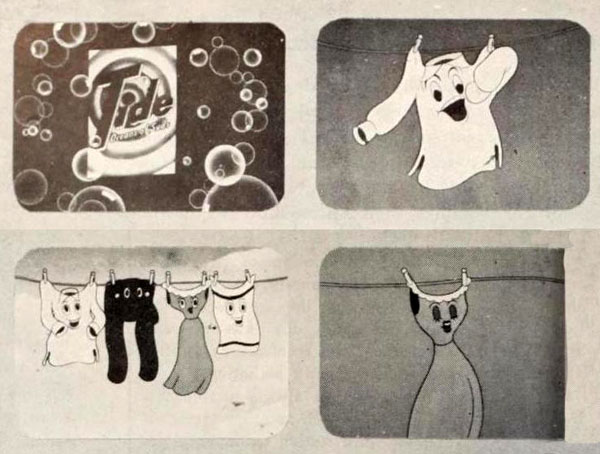
Ben Harrison’s animated Tide commercial (Sponsor, December 19, 1949)
1950—Started Chesterfield commercials, and the New York Giants. Went coast to coast doing baseball commercials from New York to California…including stop-motion action on two one-minute spots including live-action.
Harrison had begun work on these commercials earlier—the May 1949 issue of Mechanix Illustrated featured a two-page spread detailing the production of a stop-motion commercial promoting Chesterfield cigarettes at Harrison’s studio.
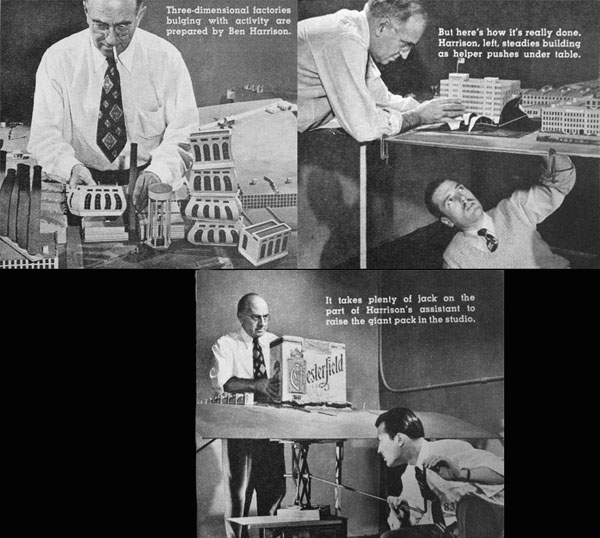
Harrison and assistant working on a stop motion spot for Chesterfield cigarettes
From 1950 to 1960, I continued animated, live, and other types of commercials too numerous to mention, up in the hundreds…
Howard Beckerman recalls a meeting with Harrison on 45th St., in November 1951; Harrison offered Beckerman a job at his studio, but Howard had to refuse: “The Korean War was in progress and I had been drafted… Harrison called me on Thursday, Thanksgiving Day. I told him, sorry, I was reporting to the Army induction center on Monday.”
Harrison also hired the teenage Myrna during her summer vacations in the early 1950s, whereupon she worked as an in-betweener, inker, opaquer and occasional background painter. After Myrna married her husband, Earl Pierce, in 1954, Myrna and Earl painted backgrounds for her father’s productions together.
By the following year, Harrison moved his operations to 112 West 89th Street. Broadcasting trade magazines mention his studio, and its specialty of television commercials, as late as 1954. It is unclear when Harrison’s studio closed; Myrna recollects that it eventually went bankrupt.
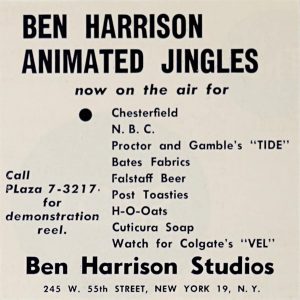
In 1960 to 1970, I tied up with a jingle outfit that wrote radio jingles. They had many salesmen and they would bring 6 to 10 spots in at a time…Then we had an export-import agency and we did an awful lot of Spanish commercials. One of them was the Devil was trying to get into Heaven…and he tried to break thru the gate, but the reason he couldn’t get in was that there was a Yale lock in the door. Lately, I’ve been doing a few commercials but I’m spreading them out more and more…I’m sure I’ve forgotten quite a few but I think this gives you a pretty fair idea of what I’ve been doing…
Author/historian John Canemaker, researching his book Felix: The Twisted Tale of the World’s Most Famous Cat, corresponded with Harrison via phone conversations and letters. Harrison’s letter to Canemaker dated January 23, 1978, mentions that Harrison’s home studio was located at 98-76 Queens Blvd. in Forest Hills, New York. In that same letter, Harrison mentions having traveled to Hollywood a few years prior, where he met up with his old partner Manny Gould; as of January 1978, Gould had been dead for nearly three years. Harrison died in April 1980 in Queens, New York, though no exact date can be determined in lieu of accessible death records or obituaries. Afterwards, his widow Ruth moved with Myrna to Phoenix, Arizona.
For the sake of validity, Harrison’s hand-written notes can be seen here at this link.
(Thanks to Jerry Beck, David Gerstein, Mark Newgarden, Yowp, Steve Marshall, Michael Barrier, Howard Beckerman, John Canemaker, Richard O’Connor, Robert Coar, Joe Campana, John McGregor, and Myrna Harrison for their help with this post.)


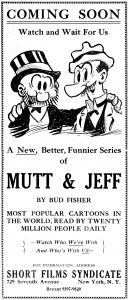
 DEVON BAXTER is a film restoration artist, video editor, and animation researcher/writer currently residing in Pennsylvania. He also hosts a
DEVON BAXTER is a film restoration artist, video editor, and animation researcher/writer currently residing in Pennsylvania. He also hosts a 




















































































Harrison’s stammering problem, or lingering embarrassment over it, may have been the reason he took the trouble to write down these reminiscences of his career for the unnamed interviewer. In any case, I think it’s great that this document has survived. His honesty and self-effacing humour bespeak a very likable personality.
Whenever I’ve seen Ben Harrison’s name on the credits of a Mintz cartoon, I always wondered if he was related to the 23rd president and his great-grandfather, the Virginia governor who signed the Declaration of Independence. Apparently not.
The unfinished Associated Animators documentary would have been about the airship USS Shenandoah, which crashed in a storm over Ohio (not Pennsylvania) on the 3rd of September 1925. It was the first rigid dirigible built by the US Navy, the first to use helium rather than hydrogen, and the first airship to cross North America from Atlantic to Pacific. Paul Terry depicted it in his 1924 Aesop’s Fables cartoon “If Noah Lived Today”.
The “Dr. Graf” Harrison mentioned in the paragraph about his first cartoon sale to NBC was Herbert Graf, stage director (not choral master) of the Metropolitan Opera. Although the Met’s first television broadcasts were indeed aired by that network, by 1948 they were being broadcast on ABC; in fact their production of Verdi’s “Otello” that year was the first television broadcast of a complete opera. But Graf might have had some connection with NBC apart from his position at the Met. Graf, incidentally, as a five-year-old child was the subject of a famous case study by Sigmund Freud.
I hope to see some of Harrison’s early newspaper cartoons and later commercial work in a future post.
Very interesting. Fills in a bunch of gaps.
Devon, in the immortal words of Tom, this article is “TEEE-RIFFIC!” Ben Harrison’s trade marks in his Columbia cartoons were the parades, good examples of which are in “Bon-Bon Parades” as the Christmas pageant proceeds along the streets of Candy Town. I think in “Let’s Go”, another Color Rhapsody, there are a lot of street parades celebrating the working men and women of America, performed by bugs! I really enjoyed this article, and how you tied in “Pen and Ink Vaudeville” to Ben’s time line.
Look how young and adorable Shamus Culhane was in the back row in the Krazy Kat staff shot.
I wouldn’t have thought of “Bon Bon Parade” as a Christmas perennial, since there’s also Easter, Valentine’s Day, and ending with 4th of July fireworks. Say what you will about the Color Rhapsodies (particularly if you were there like Mr. Harrison), as a body of work they beat the hell out of the Fleischer Color Classics.
Thank you for a really wonderful piece.
I should point out that Max Fleischer’s lawsuit against Associated Animators also named Edith Vernick as a defendant, in addition to Harrison Burt Gillette and Emanuel Goldman. Vernick eventually went back to Fleischer and became known as a fierce loyalist. She became head of the Inbetween Department where the leadership of the 1937 Fleischer strike emerged and management seems to have blamed her, at least in part, for the walkout. She was a more interesting character than is usually thought. In any case when I interviewed her she never mentioned her involvement with Associated Animators.
Thanks for this post, Devon! Harrison has been of interest to me ever since I picked up on his work in the early-30s Krazy Kat cartoons. Heck, I think his work even earns the credit for starting me down the path of studying the animation in these and other early sound cartoons in recent years, and identifying what can be identified; the odd eye-squinting that he liked to use during that period kinda got my attention. It’s great to read some of his own memories and gain additional insight into his life and career – as it always is with these lesser-known animation artists and those who worked at lesser-known studios of interest such as Mintz.
Some insight into Harrison’s sensibilities can be gleaned from examining the cartoons he solo-directed during the 1931-32 Krazy Kat season, and comparing them with the ones Manny Gould directed and the earlier and later seasons they co-directed. The 1931-32 season is most unique and interesting because it is the one season where Harrison and Gould “split up” and directed their own cartoons. Or maybe it was more that Harrison “split off” to do his own cartoons, given that Gould helmed the majority of the cartoons that season, with the usual crew of subordinate animators, while Harrison only did four (Piano Mover, The Birth of Jazz, The Paper Hanger, and Light House Keeping); and the first three appear to contain a substantial amount of Harrison’s own animation, the first almost entirely so. (The sloppiness and indifference of Samba Pictures sadly resulted in TV prints of the first three carrying bogus credits attributing them to Gould and crew instead of Harrison, but the Catalog of Copyright Entries records and study of the films themselves help set the record mostly straight.)
Among the observations to be made are the aforementioned squinting eyes for the sake of squinting, and his fondness of squashy, stretchy, and generally rubbery rubber-hose animation; much more so than demonstrated in Gould’s work.
Looking forward to any further information or examples of Harrison’s print cartoons that you manage to unearth.
For that matter, any further installments of “Complimentary Mintz” would be welcome, as the first entry touched only on some of the earlier sound cartoons, while there are certainly more that are worthy of examination. It is my hope that my comment at the time pointing out errors among the animation IDs in that article did not demolish any motivation to continue that series; it was not my intention to cast a shadow on the competence of the authors in that endeavor, but simply to prevent mistakes from entering the public record unchallenged; corroboration of much of what was correct was omitted in the interest of not making a rather lengthy comment even lengthier. I’d be willing to contribute any assistance or insight I could. There can’t be enough scholars studying cartoons from this era and ferreting out insight on the early work of artists notable and obscure, yet it is a lonely and neglected pursuit.
THANK YOU, Devon! What a great post! And what a fascinating life Ben Harrison lived.
Seriously, reading this post was like watching a great film as I was on the edge of my seat, wondering what was going to happen next! Great job in writing such a thrilling history of the life of one man in animation history. KUDOS!